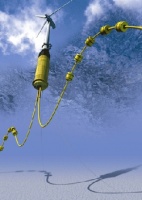For the energy sector, the last 12 months might best be remembered as the year the Energy Bill delivered the long-awaited Electricity Market Reform that was passed by Parliament, or the year that the cost of living debate reached its loudest point. While this has been a whirlwind year with various facets of energy policy being pinched, preened, polished and indeed punched, for me, 2013 is the year that wind power technology stormed ahead.
The renewables sector is on track to provide around 70,000 jobs up and down the country in the next 10 years, offshore and onshore wind is credited with creating almost £70,000 for the British economy for every megawatt of capacity installed, and the UK offshore wind industry has been crowned as the most attractive destination for investors according to Ernst and Young. Last month, we witnessed a record-breaking amount of clean electricity being generated in a day with wind power contributing more than 6 gigawatts (over 6,000 megawatts) to the National Grid for the first time – that’s enough to power more than 3.4 million British homes.
These are all important milestones to celebrate, but on reflection, what made me the most proud was the unprecedented level of collaboration between industry innovators, developers, supply chain companies and wind power supporters which has led to groundbreaking technological advances in the sector. These pioneers are driving down the cost of wind energy as well as improving safety levels, attracting skilled workers and re-establishing the UK as the epicenter of industrial prowess that it was once renowned for.
One of the most exciting and high profile innovations in wind this year has been Statoil’s advancements in floating turbine technology. After more than four years of testing a full scale turbine off the western coast of Norway, the concept is technologically proven. The Hywind Scotland Pilot Park project, at a site in Buchan Deep, approximately 30km off the coast of Peterhead, Aberdeenshire, aims to demonstrate technical and commercial feasibility for future offshore floating wind projects.
With a large part of the world’s offshore wind resources located in deep waters, Senior Vice President for Renewable Energy in Statoil, Siri Espedal Kindem said; “Floating wind has advantages in terms of fabrication, installation and environment. Floating wind will be cost-competitive in the future as technology matures. Floating wind turbines can be standardised for each project or region, allowing for mass production, whereas the substructures of fixed offshore wind turbines have to be adapted to each individual position within the offshore windfarm.” Statoil also point out that as the assembly of floating wind turbines can be done onshore or inshore and then be towed to the final location, smaller vessels can be utilised and weather delays are less of an issue, thus reducing construction and maintenance costs.

It isn’t just these large scale engineering feats that are giving the wind industry a name for forward thinking. Financial and risk management innovations, such as the insurance products offered by renewable services provider GCube throughout project phases, and DONG Energy’s ‘High Five’ approach to improving communications between offshore services to lower costs, are crucial to allow the sector to achieve its full potential. The National Renewables Energy Centre (Narec) has also received investment from the European Regional Development Fund (ERDF) to develop a Renewable Energy Technology Accelerator (RETA) programme to collaborate with industry; encouraging and supporting companies in North East England to develop new products, such as inter array cable trenchers, across the supply chain for the offshore renewable energy market.
”Floating wind turbines can be standardised for each project or region, allowing for mass production, whereas the substructures of fixed offshore wind turbines have to be adapted to each individual position within the offshore windfarm
Siri Espedal Kindem, Senior Vice President for Renewable Energy, Statoil
Supply chain companies up and down the country have also been making state-of-the-art developments for the industry. It hasn’t just been Amazon making headlines this year with its delivery drones, Livingston based aerial inspection and surveying company Cyberhawk has been working closely with developers to assist in the growth of offshore wind industry. They demonstrated their remotely operated aerial cameras at the Greater Gabbard Offshore Wind Farm opening in August this year, highlighting that drones are reducing the need for people to be placed in potentially dangerous locations. Additionally, using advanced photogrammetric techniques, drones can generate an accurate digital elevation model of wind farm sites allowing developers to design access roads, turbine locations and laydown areas. This data in turn also helps speed up environmental impact assessments.
This year subsea and offshore grouting specialist FoundOcean have also taken significant steps towards industrialising the onshore grouting process and offshore connections for turbines. Explaining the importance of these developments, Damien Murphy, Engineering Director for FoundOcean says this represents a radical step for the renewables sector helping contribute to a significant reduction in the time it take to grout and therefore lay a foundation.
The wind sector is one that is often cited as being in its infancy; however, looking back over the successes we have achieved this year, the wind sector is perhaps better described as an eager and fresh faced 20 some-thing, looking to embark on a long and successful career.
This is just a snap shot of some of the fascinating innovations being made by the wind industry. These advances continue to make wind one of the most attractive ways to generate clean energy and reduce our dependency on costly imported fossil fuels and protect UK consumers.




Red Bull makes hydrogen fuel cell play with AVL
Formula 1 is an anachronistic anomaly where its only cutting edge is in engine development. The rules prohibit any real innovation and there would be...